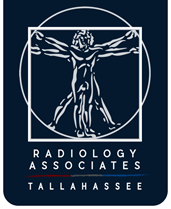Breast Ultrasound
Ultrasound is safe and painless, and produces pictures of the inside of the body using sound waves. Ultrasound examinations do not use ionizing radiation (as used in x-rays), thus there is no radiation exposure to the patient.
Learn More About Breast Ultrasound
Breast ultrasound is a non-invasive tool used to evaluate specific, often palpable areas of concern – such as a breast lump felt by a patient or physician and an area of concern seen on a mammogram. Breast ultrasound does not replace the need for mammography. Mammogram images are still needed to evaluate the entire breast. An ultrasound examination produces images of your breast using inaudible sound waves in a frequency range far above the range of human hearing.
Ultrasound imaging of the breast produces a picture of the internal structures of the breast. The primary use of breast ultrasound is to help diagnose breast abnormalities detected by the woman or her doctor and to characterize potential abnormalities seen on mammography. A breast ultrasound is used to help determine whether a breast lump is filled with fluid (such as a cyst) or solid. An ultrasound does not replace the need for a mammogram, but it is often used in certain circumstances to image specific areas of the breast.
There are no pre-procedure preparations for this scan.
Upon completion, patients may resume normal activities. A radiologist will analyze the images taken by the sonographer. Reports will be sent to your physician with 5 business days. You may contact your physician for any information pertaining to the findings.
- Ultrasound is one of the tools used in breast imaging, but it does not replace annual mammography.
- Many cancers are not visible on ultrasound. Many calcifications seen on mammography cannot be seen on ultrasound. Some early breast cancers only show up as calcifications on mammography. MRI findings that are due to cancer are not always seen with ultrasound.
- Biopsy may be recommended to determine if a suspicious abnormality is cancer or not.
- Most suspicious findings on ultrasound that require biopsy are not cancers.
- It is important to choose a facility with expertise in breast ultrasound, preferably one where the radiologists specialize in breast imaging. Radiology Associates is the center in our area with the ACR Gold Seal for Breast Excellence.
Your breast ultrasound will be performed by a mammography-certified, female technologist trained in ultrasound imaging. After you check in, you will be escorted to a private dressing room, where you will be asked to undress from the waist up. You will be given a gown that opens in the front. The technologist will ask you several questions, so she can better understand your history and/or any problems you may be having.
You will lie on your back with your arm raised above your head on the examining table. The sonographer presses the transducer firmly against the skin, moving it back and forth over the area of interest until the desired images are captured. Typically there is no pain involved, but due to the amount of pressure it may be uncomfortable.
A breast ultrasound test usually takes between 15 and 30 minutes. More time may be needed if a physical breast exam is needed or if a biopsy is planned. A physician specialized in breast imaging will review your images and may also want to obtain more ultrasound views of some areas of your breast.
Benefits
- Most ultrasound scanning is noninvasive (no needles or injections).
- Occasionally, an ultrasound exam may be temporarily uncomfortable, but it should not be painful.
- Ultrasound is widely available, easy-to-use and less expensive than other imaging methods.
- Ultrasound imaging is extremely safe and does not use any ionizing radiation.
- Ultrasound scanning gives a clear picture of soft tissues that do not show up well on x-ray images.
- Ultrasound provides real-time imaging, making it a good tool for guiding minimally invasive procedures such as needle biopsies and fluid aspiration.
- Ultrasound imaging can help detect lesions in women with dense breasts.
- Ultrasound may help detect and classify a breast lesion that cannot be interpreted adequately through mammography alone.
- Using ultrasound, physicians are able to determine that many areas of clinical concern are due to normal tissue (such as fat lobules) or benign cysts. For most women 30 years of age and older, a mammogram will be used together with ultrasound. For women under age 30, ultrasound alone is often sufficient to determine whether an area of concern needs a biopsy or not.
Risks
- For standard diagnostic ultrasound, there are no known harmful effects on humans.
- Interpretation of a breast ultrasound examination may lead to additional procedures such as follow-up ultrasound and/or aspiration or biopsy. Many of the areas thought to be of concern turn out to be non-cancerous.
Your physician should make your appointment by calling 850-878-6104.
